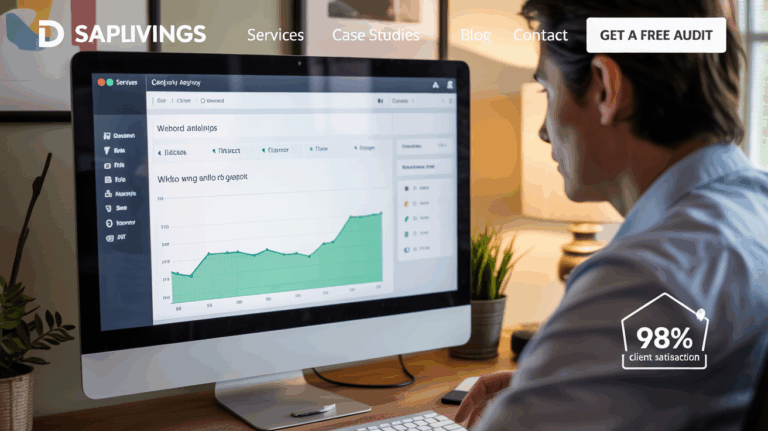How to Perform a Complete SEO Audit in Under 1 Hour
Evaluating Site Performance
Evaluating a website’s performance is absolutely crucial when it comes to pinpointing those pesky elements that might stifle search engine visibility. Dive into tools like Google PageSpeed Insights and GTmetrix—these gems are your best friends for uncovering the secrets of load times and user experience. They serve up invaluable metrics, such as First Contentful Paint and Time to Interactive, which can feel like gold dust in the quest for optimization. Keeping an eye on these factors ensures that visitors glide smoothly through your site, potentially slashing bounce rates while elevating engagement levels.
But wait—there’s more! Beyond mere load speed lies the ever-important realm of mobile-friendliness, a key player in the game of site performance evaluation. With hordes of users tapping away on their phones and tablets, tailoring experiences for various screen sizes isn’t just important; it’s essential! A responsive design doesn’t merely enhance user satisfaction—it also sends positive ripples through search engine rankings. Regularly checking up on site speed alongside mobile optimization isn’t just good practice; it’s vital for nurturing a website’s vitality and boosting its chances of holding onto visitors like never before!
Measuring Load Speed and User Experience
The speed at which a website loads isn’t just a number; it’s the very pulse of user experience and a pivotal factor in search engine rankings. Tools galore, such as Google PageSpeed Insights and GTmetrix, stand ready to dive deep into this essential metric. They don’t merely spit out figures—they unveil the intricate tapestry of loading performance while offering tangible recommendations for turbocharging that speed. Scrutinizing load times across a kaleidoscope of devices and network conditions allows us to pinpoint those pesky areas craving improvement, ensuring users enjoy an experience that feels seamless no matter how they access it.
Yet, let’s not be deceived: user experience stretches far beyond mere velocity. It weaves together mobile compatibility, intuitive navigation paths, and captivating content displays like threads in an elaborate quilt. Digging into bounce rates and average session durations with tools like Google Analytics sheds light on how effectively visitors engage with the site. A glaringly high bounce rate? That could be your red flag—hinting at usability hiccups or content that simply doesn’t resonate with expectations. By honing both load speed and enriching overall user experience, websites can spark greater engagement and retention rates—a symbiotic dance leading inevitably to enhanced SEO prowess!
Conducting Keyword Research
Keyword research is the bedrock upon which any thriving SEO strategy stands. It’s all about pinpointing those crucial terms and phrases that your intended audience types into search engines when hunting for products or services akin to yours. Harnessing tools such as Google Keyword Planner, Ahrefs, or SEMrush opens up a treasure trove of high-traffic keywords; you can gauge their search volumes and sift through the competition they attract. This rich tapestry of data empowers you to craft a focused keyword list that resonates with user intent, thus paving the way for organic traffic to flow in.
But wait—there’s more! It’s not just about unearthing fresh keywords; evaluating where your current ones land in rankings is equally vital. Delving into which keywords are steering visitors toward your site while identifying voids within your content strategy can illuminate your next moves. Grasping how you stack up against competitors may uncover golden opportunities for refining content around potent keywords. This intricate dance of research and analysis culminates in a sharper strategy, ensuring that your website stays at the forefront of search engine results amidst an ever-evolving digital landscape.
Analyzing Current Keyword Rankings and Gaps
Grasping the intricacies of current keyword rankings is vital for uncovering those elusive areas where a website might be lagging behind. Tools like Google Search Console or various third-party software can unveil fascinating insights into the performance of specific keywords—each ranking tells a story! But wait, there’s more: keeping an eagle eye on ranking fluctuations is imperative since search engine algorithms are in constant flux, shifting like sands in an hourglass. This deep dive should also delve into the relevance and intent entwined with each keyword, ensuring they harmonize seamlessly with your overarching content strategy.
Now, let’s talk about identifying gaps—this involves scrutinizing keywords for which your competitors have claimed victory while your site remains adrift. A diligent competitive analysis serves as a compass to navigate toward high-value keywords that shimmer with potential for growth. By honing in on these gaps, you can craft a focused strategy aimed at generating content that zeroes in on these specific terms. This targeted method seeks not only to elevate rankings but also to amplify organic traffic and boost overall visibility across the digital landscape!
| Keyword | Current Ranking | Competitor Ranking | Search Volume | Opportunity Score |
|---|---|---|---|---|
| Best SEO Practices | 8 | 5 | 3,600 | 70 |
| Content Marketing Strategies | 12 | 3 | 2,900 | 75 |
| Local SEO Tips | 15 | 10 | 1,800 | 60 |
| Keyword Research Tools | 20 | 6 | 2,200 | 80 |
Assessing Backlink Profile
A robust backlink profile stands as a fundamental pillar in the realm of effective search engine optimization. Delving into the quality and quantity of backlinks can unlock precious insights about a website’s authority and trustworthiness—like peering through a keyhole into its digital reputation. Start your journey with tools such as Google Search Console, Ahrefs, or SEMrush to collect data on referring domains and how those backlinks are scattered across the web. Set your sights on high-authority sites within your niche; these connections can catapult your site’s credibility to new heights.
But wait! It doesn’t end there. Beyond merely assessing the strength of those elusive backlinks, you must scrutinize anchor text diversity and relevance like an art critic examining a masterpiece. A harmonious distribution of anchor text whispers to search engines that your site is indeed a treasure trove of valuable information. Meanwhile, keep an eagle eye out for any insidious backlinks lurking in the shadows—those could spell trouble and lead to penalties worse than bad reviews at a diner. Disavowing these troublesome links becomes paramount for safeguarding that pristine backlink profile you’ve worked so hard to build.
So roll up those sleeves! Conducting a meticulous review will not only inform future strategies but also lay down the groundwork for crafting an even more formidable link-building campaign ahead!
Reviewing Quality and Quantity of Backlinks
A robust backlink profile isn’t just important—it’s absolutely vital for boosting a website’s authority and climbing the ranks in search engine results. Start by diving into the sheer number of backlinks that are pointing toward your domain. Tools like Ahrefs or Moz can offer you a detailed snapshot, revealing not only the total count but also how many unique referring domains are involved. Generally speaking, more high-quality backlinks tend to equate to greater visibility on those coveted search engine pages; however, don’t forget: quality matters as much—if not more—than quantity.
When it comes to evaluating these links, think quality over quantity every time. Target reputable sources that resonate with your industry’s ethos. Look at metrics like Domain Authority (DA) or Page Authority (PA); they serve as barometers for gauging the might of linking sites. And let’s not overlook context! Backlinks nestled within relevant content pack a heavier punch than those languishing in footers or buried among comment sections. Plus, taking steps to disavow low-quality or downright spammy backlinks can significantly bolster your site’s credibility and elevate its standing in search rankings overall.
- Regularly audit your backlink profile to identify quality links and potential issues.
- Utilize tools like Google Search Console to monitor your backlinks and receive alerts on any harmful links.
- Focus on building relationships with influencers and thought leaders in your industry to earn high-quality backlinks.
- Engage in guest blogging to naturally incorporate backlinks within relevant and authoritative content.
- Keep abreast of algorithm updates from search engines to understand how they impact backlink significance.
- Employ a diverse backlink strategy that includes various types of links, such as dofollow and nofollow, to improve overall link diversity.
- Continuously adapt your backlink strategies based on performance metrics and competitor analysis to stay competitive.
Monitoring Competitor SEO Strategies
Delving into the tactics wielded by your competitors can unveil a treasure trove of insights for refining your own SEO strategy. Start by pinpointing those key players in your industry who’ve managed to eclipse you in search engine results. Harness powerful tools like SEMrush or Ahrefs—these are your magnifying glasses, allowing you to dissect their keywords, scrutinize their backlinks, and unravel their content strategies.
Don’t overlook the nitty-gritty of on-page SEO elements: title tags that pop, meta descriptions that entice, header structures that guide—all these could be secret ingredients fueling their superior visibility.
Dive deeper into competitor content and gauge engagement levels across social media platforms; this is where audience interaction flourishes and preferred topics bubble up to the surface. Such intel can illuminate content gaps ripe for exploration on your own site. By curating a compendium of successful strategies from rivals, you’re poised to adapt and elevate your approach—an endeavor aimed squarely at boosting your site’s performance amidst the relentless tides of search engine rankings.
Identifying Key Competitors and Their Tactics
Diving into the chaotic realm of competition is absolutely vital for crafting a killer SEO strategy. Start by pinpointing the major players strutting their stuff in your industry. Leverage powerful tools like SEMrush, Ahrefs, or Moz to assemble a roster of rivals based on overlapping keywords and market visibility. Take a good look at their websites—how they’re designed, how users navigate through them, and what content strategies they employ. This detailed examination will expose their strengths and weaknesses like an open book, revealing golden opportunities to elevate your own site.
Once you’ve got your top competitors lined up, plunge deep into their tactics by dissecting various facets of their SEO game plan. Zero in on the keywords they’re chasing after, scrutinize the quality and regularity of their content output, and dig into where they’re snagging those backlinks from. Don’t forget about social media! Analyzing how they engage with audiences there can uncover intriguing methods they’ve harnessed to forge connections. Piecing together this information won’t just illuminate what’s driving success for them; it’ll ignite fresh ideas that could propel you ahead in this competitive landscape!
Formulating an Action Plan
After sifting through the insights gleaned from the audit, it becomes imperative to spotlight those areas ripe for enhancement. Begin by sorting issues according to their potential clout on site performance and user experience—this is where the magic happens. High-impact changes, like turbocharging load speed and tackling significant usability hiccups, should leap to the forefront of your action plan. Once you’ve tackled these giants, pivot towards fine-tuning keywords and enriching content; after all, aligning with user intent and boosting search visibility is paramount.
Then comes the crucial step: laying down clear-cut, measurable goals for each SEO initiative you embark upon. Map out timelines and designate responsibilities—accountability is key here! Keep a vigilant eye on how these initiatives are progressing; tracking effectiveness isn’t just smart—it’s essential. This flexible strategy not only accommodates shifts in SEO trends but also adapts to changing user behaviors, nurturing ongoing growth while steadily climbing those search rankings.
Prioritizing SEO Improvements Based on Findings
In the intricate world of SEO, the art of prioritization emerges as a linchpin for crafting impactful enhancements. Begin this journey by sorting through the myriad issues you’ve unearthed, categorizing them according to their potential fallout on both site performance and user experience—think of it as organizing chaos into clarity. First and foremost, direct your attention to those glaring critical errors: broken links that lead nowhere and sluggish load times that test even the most patient users; these are akin to speed bumps on a racetrack, seriously impeding user engagement.
Then comes a crucial phase—dive deep into keyword opportunities and uncover content voids that could serve as golden tickets to improved search visibility. Here’s where you should zero in on tasks promising the heftiest return on investment regarding time and resources; after all, efficiency is key!
As you forge ahead with your action plan, don’t forget to take stock of your competitive landscape. Peer closely at what competitors do well—and not so well—adjusting your priorities accordingly to capitalize on their weaknesses while honing in on areas ripe for improvement in your own strategy. Assign timelines for each enhancement like pieces in a puzzle, ensuring quick wins aren’t overshadowed by larger projects demanding more time and effort.
This methodical approach paves the way for ongoing monitoring and fine-tuning of strategies—a necessity in an ever-shifting digital arena where agility reigns supreme!
Conclusion
Diving into a thorough SEO audit in just an hour can remarkably elevate your website’s performance and visibility. By meticulously dissecting site performance, keyword strategies, backlink profiles, and competitor maneuvers, marketers can swiftly pinpoint areas ripe for enhancement—ensuring that efforts are zeroed in on those high-impact adjustments.
The revelations from this kind of audit lay the groundwork for a strategic action plan. By prioritizing these insights, businesses can deftly allocate resources where they’ll make the biggest splash, driving improved results and ultimately propelling organic search rankings upward. Regularly engaging in SEO audits not only helps maintain a competitive edge but also cultivates ongoing growth within digital marketing endeavors.
FAQS
What in the world is an SEO audit?
Picture this: an SEO audit is like a thorough check-up for your website, delving deep into its performance, structure, content, and overarching strategies to pinpoint those pesky areas that need a makeover—ensuring you shine brightly in search engine results!
How much time should I carve out for an SEO audit?
Believe it or not, you can whip up a comprehensive SEO audit in less than an hour! But hold on—a lot depends on how vast your website is and how tangled the issues are that you’re untangling.
Which nifty tools can help me gauge load speed and user experience?
Tools galore! Google PageSpeed Insights, GTmetrix, and WebPageTest stand ready to help you measure load times while peeling back the layers of user experience—each one a gem in its own right.
How do I sift through current keyword rankings and discover hidden gaps?
Dive headfirst into keyword research tools like SEMrush, Ahrefs, or Google Search Console. These powerful allies will assist you in dissecting your existing keyword rankings while unearthing those elusive gaps just waiting to be filled!
Why bother with evaluating a website’s backlink profile?
Oh boy! Assessing backlinks isn’t just important—it’s essential. Backlinks play a pivotal role in shaping domain authority and swaying search engine standings. By understanding both their quality and quantity, you’ll unveil opportunities ripe for enhancement!
What’s the secret sauce for keeping tabs on my competitors’ SEO game plan?
Keep your eyes peeled using savvy tools such as SEMrush, Ahrefs, or Moz—they’re treasure troves of insights into competitor keyword usage and backlink strategies. They’ll reveal what others are doing well—or not so well—in their quest for online visibility.
After wrapping up my SEO audit, what should my action plan entail?
A stellar action plan should highlight priority improvements stemming from your findings; delineate specific steps forward; assign who does what; plus set deadlines that’ll keep everyone accountable during implementation.
Should I tackle an SEO audit solo or call in the pros?
* Sure thing—you can absolutely roll up your sleeves and conduct an independent SEO audit using various handy tools. However—and it’s quite the significant however—hiring a professional may unlock deeper insights that could be crucial if you’re wrestling with larger or more complex websites!*







